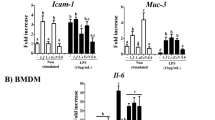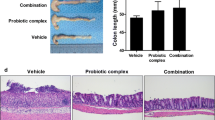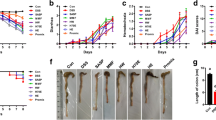Abstract
Background
An imbalance in gut microbiota seems to contribute to the development of chronic inflammatory disorders of the gastrointestinal tract, such as ulcerative colitis (UC). Although it has been suggested that probiotic supplementation is an effective approach to colitis, its effects on intestinal flora and on mucosal cytokine balance have never been explored.
Aim
To evaluate the effect of Lactobacillus casei (L. casei) DG, a probiotic strain, on colonic-associated microbiota, mucosal cytokine balance, and toll-like receptor (TLR) expression.
Methods
Twenty-six patients with mild left-sided UC were randomly allocated to one of three groups for an 8-week treatment period: the first group of 7 patients received oral 5-aminosalicylic acid (5-ASA) alone, the second group of 8 patients received oral 5-ASA plus oral L. casei DG, and the third group of 11 patients received oral 5-ASA and rectal L. casei DG. Biopsies were collected from the sigmoid region to culture mucosal-associated microbes and to assess cytokine and TLR messenger RNA (mRNA) levels by quantitative real-time polymerase chain reaction (RT-PCR).
Results
5-ASA alone or together with oral L. casei DG failed to affect colonic flora and TLR expression in a significant manner, but when coupled with rectally administered L. casei DG, it modified colonic microbiota by increasing Lactobacillus spp. and reducing Enterobacteriaceae. It also significantly reduced TLR-4 and interleukin (IL)-1β mRNA levels and significantly increased mucosal IL-10.
Conclusions
Manipulation of mucosal microbiota by L. casei DG and its effects on the mucosal immune system seem to be required to mediate the beneficial activities of probiotics in UC patients.



Similar content being viewed by others
References
Kelly D, Conway S, Aminov R. Commensal gut bacteria: Mechanisms of immune modulation. Trends Immunol. 2005;26:326–333.
Sartor RB. Enteric microflora in IBD: Pathogens or commensal? Inflamm. Bowel Dis. 1997;3:230–235.
Mimura T, Rizzello F, Helwig U, et al. Once daily high dose probiotic therapy (VLS#3) for maintaining remission in recurrent or refractory pouchitis. Gut. 2004;53:108–114.
Gionchetti P, Rizzello F, Heiwug U, et al. Prophylaxis of pouchitis onset with probiotic therapy: A double-blind, placebo-controlled trial. Gastroenterology. 2003;124:1202–1209.
Dotan I, Rachmilewitz D. Probiotics in inflammatory bowel disease: Possible mechanisms of action. Curr Opin Gastroenterol. 2005;21:426–430.
White NR, Mulligan P, King PJ, et al. Sodium butyrate-mediated Sp3 acetylation represses human insulin-like growth factor binding protein-3 expression in intestinal epithelial cells. J Pediatric Gastroenterol Nutr. 2006;42:134–141.
Ewaschuk JB, Walker JW, Diaz H, et al. Bioproduction of conjugated linoleic acid by probiotic bacteria occurs in vitro and in vivo in mice. J Nutr. 2006;136:1483–1487.
Bassaganya-Riera J, Reynolds K, Martino-Catt S, et al. Activation of PPAR gamma and delta by conjugated linoleic acid mediates protection from experimental inflammatory bowel disease. Gastroenterology. 2004;127:777–791.
Voltan S, Martines D, Elli M, et al. Lactobacillus crispatus M247-Derived H2O2 Acts as a Signal Transducing Molecule Activating Peroxisome Proliferator Activated Receptor-γ in the Intestinal Mucosa. Gastroenterology. 2008;135:1216–1227.
Cario E. Bacterial interactions with cells of the intestinal mucosa: Toll-like receptors and NOD2. Gut. 2005;54:1182–1193.
Agrawal S, Agrawal A, Doughty B, et al. Cutting edge: Different Toll-like receptors agonist instruct dendritic cells to induce distinct Th responses via different modulation of extracellular signal-regulated kinase-mitogen-activated protein kinase and c-Fos. J Immunol. 2003;171:4984–4989.
Beutler B. Inferences, questions and possibilities in Toll-like receptor signalling. Nature. 2004;430:257–263.
Netea MG, Van der Meer JWM, Kullberg BJ. Toll-like receptors as an escape mechanism from the host defense. Trends Microbiol. 2004;12:484–488.
Voltan S, Castagliuolo I, Elli M, et al. Aggregating phenotype in Lactobacillus crispatus determines intestinal colonization and TLR2 and TLR4 modulation in murine colonic mucosa. Clin Vaccine Immunol. 2007;14:1138–1148.
Cario E, Gerken G, Podolsky DK. Toll-like receptor 2 controls mucosal inflammation by regulating epithelial barrier function. Gastroenterology. 2007;132:1359–1374.
Cario E, Podolsky DK. Differential alteration in intestinal epithelial cell expression of Toll-like receptor 3 (TLR3) and TLR4 in inflammatory bowel disease. Infect Immun. 2000;68:7010–7017.
Cario E, Podolsky DK. Intestinal epithelial TOLLerance versus inTOLLerance of commensals. Mol Immunol. 2005;42:887–893.
Castagliuolo I, Galeazzi F, Ferrari S, et al. Beneficial effect of auto-aggregating Lactobacillus crispatus on experimentally induced colitis in mice. FEMS Immunol Med Microbiol. 2005;43:197–204.
Nanda Kumar NS, Balamurugan R, Jayakanthan K, et al. Probiotic administration alters the gut flora and attenuates colitis in mice administered dextran sodium sulfate. J Gastroenterol Hepatol. 2008;23:1834–1839.
Edwards FC, Truelove SC. The course and prognosis of ulcerative colitis. Gut. 1963;4:299–315.
Baron J, Connell A, Lennard-Jones A. Variation between observers in describing mucosal appearances in proctocolitis. Br Med J. 1964;1:189–192.
Florén CH, Benoni C, Willén R. Histologic and colonoscopic assessment of disease extension in ulcerative colitis. Scand J Gastroenterol. 1987;22:459–462.
Conte MP, Schippa S, Zamboni I, et al. Gut-associated bacterial microbiota in pediatric patients with inflammatory bowel disease. Gut. 2006;55:1760–1767.
Rivas R, Zurdo-Piñeiro EV, Mateos PF, et al. Identification of microorganisms by PCR amplification and sequencing of a universal amplified ribosomal region present in both prokaryotes and eukaryotes. J Microbiol Meth. 2004;56:413–426.
Mylonaki M, Rayment NB, Rampton DS, et al. Molecular characterization of rectal mucosa-associated bacterial flora in inflammatory bowel diseases. Inflamm Bowel Dis. 2005;11:481–487.
Seksik P, Rigottier-Gois L, Gramet G. Alterations of the dominant faecal bacterial groups in patients with Crohn’s disease of the colon. Gut. 2003;52:237–242.
Penders J, Stobberingh EE, van den Brandt PA, et al. The role of the intestinal microbiota in the development of atopic disorders. Allergy. 2007;62:1223–1236.
Penders J, Thijs C, van den Brandt PA, et al. Gut microbiota composition and development of atopic manifestations in infancy: The KOALA Birth Cohort Study. Gut. 2007;56:661–667.
Ley RE, Bäckhed F, Turnbaugh P, et al. Obesity alters gut microbial ecology. Proc Natl Acad Sci U S A. 2005;102:11070–11075.
Shiba T, Aiba Y, Ishikawa H, et al. The suppressive effect of bifidobacteria on Bacteroides vulgatus, a putative pathogenic microbe in inflammatory bowel disease. Microbiol Immunol. 2003;47:371–378.
Sheil B, Shanahan F, O’Mahony L. Probiotic effects on inflammatory bowel disease. J Nutr. 2007;137:819S–824S.
Gionchetti P, Rizzello F, Heiwug U, et al. Prophylaxis of pouchitis onset with probiotic therapy: A double-blind, placebo-controlled trial. Gastroenterology. 2003;124:1202–1209.
Kruis W, Fri P, Pokrotnieks J, et al. Maintaining remission of ulcerative colitis with the probiotic Escherichia coli Nissle 1917 is as effective as with standard mesalazine. Gut. 2004;53:1617–1623.
Cui H-H, Chen C-L, Wang J-D, et al. Effects of probiotic on intestinal mucosa of patients with ulcerative colitis. World J Gastroenterol. 2004;10:1521–1525.
Suau A, Bonnet R, Sutren M, Gordon JJ, Gibson GR, et al. Direct analysis of genes encoding 16S rRNA from complex communities reveals many novel molecular species within the human gut. Appl Environ Microbiol. 1999;65:4799–4807.
Bartosch S, Fite A, Macfarlane GT, McMurdo MF. Characteization of bacterial communities in feces from healthy volunteers and hospitalized elderly patients by using real-time PCR and effects of antibiotic treatment on the faecal microbiota. Appl Environ Microbiol. 2004;70:3575–3581.
Dethlefsen L, Huse S, Sogin ML, Relman DA. The pervasive effects of an antibiotic on the human gut micobiota, as revealed by deep 16S rRNA sequencing. PLOS Biol. 2008,6:e280 2383–2400.
Morelli L, Garbagna N, Rizzello F, Zonenschain D, Grossi E. In vivo association to human colon of Lactobacillus paracasei B21060: Map from biopsies. Dig Liv Dis. 2006;38:894–898.
Darfeuille-Michaud A, Boudeau J, Bulois P, Neut C, Glasser AL, et al. High prevalence of adherent-invasive Escherichia coli associated with ileal mucosa in Crohn’s disease. Gastroenterology. 2004;127:412–421.
Swidsinski A, Loening-Baucke V, Herber A. Mucosal flora in Crohn’s disease and ulcerative colitis - an overview. J Physiol Pharmacol. 2009;60(Suppl 6):61–71.
Linskens RK, Huijsdens XW, Savelkoul PH, Vandenbroucke-Grauls CM, Meuwissen SG. The bacterial flora in inflammatory bowel disease: Current insights in pathogenesis and the influence of antibiotics and probiotics. Scand J Gastroenterol Suppl. 2001;234:29–40.
Venturi A, Gionchetti P, Rizzello F, et al. Impact on the composition of the faecal flora by a new probiotic preparation: Preliminary data on maintenance treatment of patients with ulcerative colitis. Aliment Pharmacol Ther. 1999;13:1103–1108.
Kelly D, Campbell JI, King TP, et al. Commensal anaerobic gut bacteria attenuate inflammation by regulating nuclear-cytoplasmic shuttling of PPAR-gamma and RelA. Nat Immunol. 2004;5:104–112.
van Baarlen P, Troost FJ, van Hemert S, et al. Differential NF-kappaB pathways induction by Lactobacillus plantarum in the duodenum of healthy humans correlating with immune tolerance. Proc Natl Acad Sci U S A. 2009;106:2371–2376.
Berger J, Moller DE. The mechanisms of action of PPARs. Annu Rev Med. 2002;53:409–435.
Ortega-Cava CF, Ishihara S, Rumi MAK, et al. Strategic compartmentalization of toll-like receptor 4 in the mouse gut. J Immunol. 2003;170:3977–3985.
Zhang R, Li Y, Beck PL, et al. Toll-like receptor 4 regulates colitis-associated adenocarcinoma development in interleukin-10-deficient (IL-10(-/-)) mice. Biochem Soc Trans. 2007;35:1375–1376.
Masayuki F, Fukata M, Chen A, et al. Toll-like receptor-4 promotes the development of colitis-associated colorectal tumors. Gastroenterology. 2007;133:1869–1881.
Cario E, Gerken G, Podolsky D. Toll-like receptor 2 enhances ZO-1-associated intestinal epithelial barrier integrity via protein kinase C. Gastroenterology. 2004;127:224–238.
Seo M, Okada M, Yao T, Okabe N, Maeda K, Oh K. Evaluation of disease activity in patients with moderately active ulcerative colitis: Comparisons between a new activity index and Truelove and Witts’ classification. Am J Gastroenterol. 1995;90:1759–1763.
Acknowledgments
The authors are very grateful to Miss Linda Inverso for editing the manuscript. Source of support: MIUR and University of Padua.
Conflict of interest
None to declare.
Author information
Authors and Affiliations
Corresponding author
Rights and permissions
About this article
Cite this article
D’Incà, R., Barollo, M., Scarpa, M. et al. Rectal Administration of Lactobacillus casei DG Modifies Flora Composition and Toll-Like Receptor Expression in Colonic Mucosa of Patients with Mild Ulcerative Colitis. Dig Dis Sci 56, 1178–1187 (2011). https://doi.org/10.1007/s10620-010-1384-1
Received:
Accepted:
Published:
Issue Date:
DOI: https://doi.org/10.1007/s10620-010-1384-1




